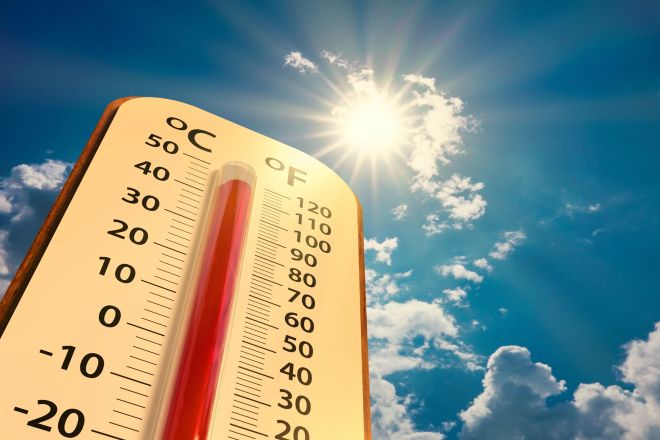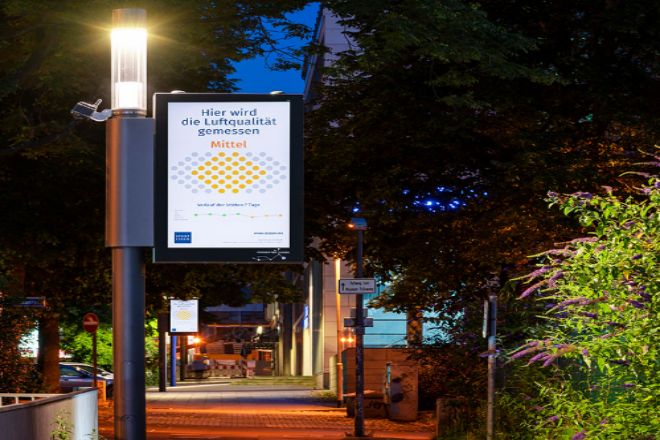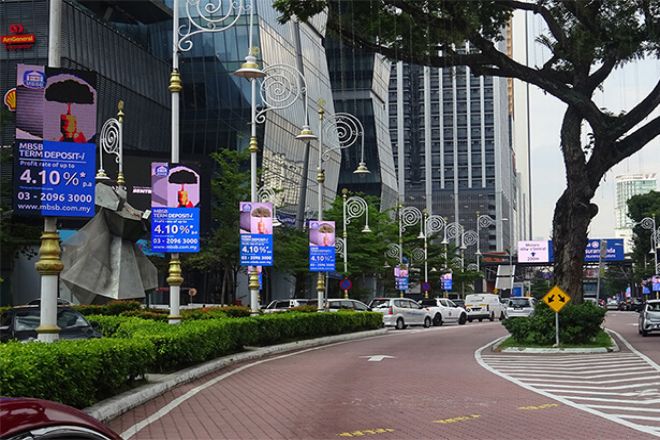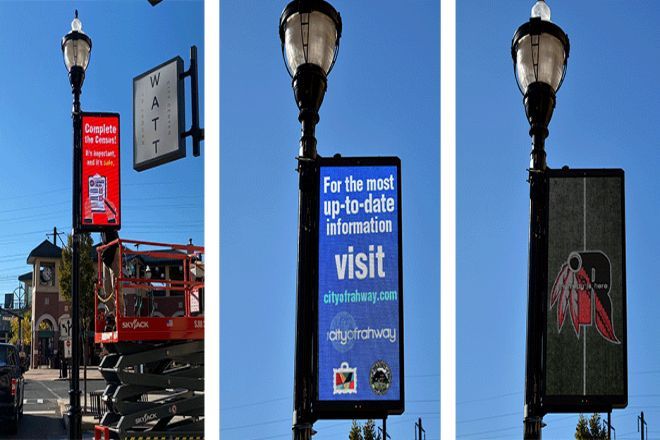소개

더운 여름에는 고온 날씨가 일상이 되었으며, 이는 특히 막대형 LED 디스플레이 화면에 대한 야외 전자 장비에 혹독한 시험을 안겨줍니다.
현대도시의 정보구축의 중요한 부분으로서, 폴 LED 디스플레이 화면은 교통 안내, 정보 발표에 널리 사용됩니다. 광고하는, 그리고 다른 분야에서도 높은 밝기, 넓은 시야각, 쉬운 설치 등의 장점을 가지고 있습니다.
그러나 고온은 LED 디스플레이 화면의 발광 효율과 수명에 영향을 미칠 뿐만 아니라, 안정성과 신뢰성을 위협하여 정상적인 작동 및 서비스 수명에도 영향을 미칩니다.
따라서 극성 LED 디스플레이 화면이 고온 날씨에 효과적으로 대처하고 고온 환경에서 안정적인 작동을 보장할 수 있는 방법을 연구하는 것은 매우 실용적인 의의와 실제적 적용 가치가 있습니다.
1. 폴 LED 디스플레이 스크린 소개

램프 폴 LED 디스플레이 화면이라고도 불리는 폴 LED 디스플레이 화면은 옥외 광고와 대중 정보 발표에 중요한 역할을 합니다.
이런 디스플레이 화면은 가로등 기둥이나 다른 공공 시설에 교묘하게 설치되어 도시 공간을 최대한 활용할 뿐만 아니라 독특한 방식으로 도시의 시각적 풍경을 풍부하게 만듭니다.
1) 주요 역할에 대한 간략한 설명:
- 정보 전파를 위한 다리:
가로등 기둥 LED 디스플레이 화면은 정보 제공자와 대중을 연결하는 중요한 다리입니다.
이러한 디스플레이는 상업 광고, 공익 광고, 비상 공지 등 다양한 정보를 보행자와 지나가는 차량에 신속하게 전달하여 광범위한 적용 범위와 시기적절한 정보 전달을 보장합니다.
- 시각적 매력을 향상시키세요:
가로등 LED 디스플레이는 일반적으로 교통량이 많은 장소에 설치되며 높은 가시성을 갖는 특성을 가지고 있습니다. 명도 밝은 색상이면 사람들의 관심을 쉽게 끌 수 있습니다.
이러한 강력한 시각적 효과로 인해 광고 내용이 더 기억에 남고 홍보 효과도 향상됩니다.
- 환경에 대한 유연한 적응:
가로등 LED 디스플레이의 디자인은 유연하고 다양하며 다양한 환경과 필요에 따라 사용자 정의할 수 있습니다. 좁은 거리이든 넓은 광장이든 정보를 효과적으로 전파하기 위해 설치에 적합한 위치를 찾을 수 있습니다.
2. 기둥에 장착된 LED 디스플레이에 고온의 영향은 무엇입니까?
기둥에 장착된 LED 디스플레이(가로등 기둥에 있는 눈부신 대형 화면)에 대한 고온의 영향은 실제로 더운 여름에 우리가 느끼는 불편함과 비슷합니다. 화면도 "열사병" 도전을 겪는 것처럼 "고온 테스트"를 겪게 됩니다.
1) 고온에서 발생할 수 있는 즉각적인 문제
- 화면 "땀흘리기":
강한 직사광선 아래에 놓이면 LED 디스플레이 내부의 전자 부품들은 용광로 속에 있는 것처럼 열을 축적하기 시작합니다. 마치 더운 여름에 인체가 땀을 흘리는 것과 같습니다.
열이 축적되면 화면 표면 온도가 급격히 상승할 뿐만 아니라 내부 회로 기판과 전자 부품이 과열될 가능성이 높습니다.
과열은 이러한 구성 요소의 정상적인 작동에 영향을 미칠 뿐만 아니라 단락 및 개방 회로와 같은 일련의 오류를 일으킬 수 있으며, 이는 결국 전체 디스플레이의 성능과 안정성에 영향을 미칩니다.
- 밝기가 약함:
고온 환경은 LED 램프 비드에 보이지 않는 요크를 씌워 빛을 방출하는 능력을 제한하는 것과 같습니다. LED 칩의 발광 효율은 온도와 밀접한 관련이 있으며 온도가 상승하면 발광 효율이 크게 감소합니다.
즉, 고온에서는 막대 LED 디스플레이의 밝기가 크게 떨어져 원래 선명했던 텍스트와 이미지가 흐릿해지고 시청 편의성과 정보 전달 효과가 크게 감소합니다.
- 색상 왜곡, 시각적 잔치 변화:
고온은 LED 디스플레이의 색상 성능에 부정적인 영향을 미칠 수도 있습니다. LED 칩의 파장은 온도 변화에 따라 변하기 때문에 표시해야 할 색상이 부정확해질 것입니다.
예를 들어, 밝은 빨간색은 칙칙하고 주황색이 될 수 있으며, 맑은 파란색은 탁하고 보라색이 될 수 있습니다.
이러한 색상 왜곡은 화면의 아름다움을 파괴할 뿐만 아니라, 청중이 정보를 이해하는 데 혼란을 주고 정보의 정확한 전달에 영향을 미칠 수도 있습니다.
2) 장기적 영향
- 물질적 노화, 젊음은 더 이상 없습니다:
LED 패키지 소재, 회로 기판, 전자 부품 등 LED 디스플레이 내부의 재료는 장기간 고온 환경에 노출되면 점차 원래 성능과 안정성을 잃게 됩니다.
그들은 점차 탄력을 잃고, 햇빛에 노출된 피부처럼 연약하고 취약해질 것입니다. 이 소재의 노화 과정은 되돌릴 수 없으며 디스플레이의 서비스 수명과 안정성을 심각하게 단축시킬 것입니다.
- 수명이 크게 단축되고 빈번한 교체가 일반화되었습니다.
고온은 무자비한 가속기와 같습니다. 그것은 극 LED 디스플레이의 노화 과정을 가속화하여 원래 수명이 길도록 설계된 디스플레이가 짧은 시간 내에 성능 저하와 잦은 고장을 겪게 합니다.
이는 사용자의 유지관리 및 사용 비용을 증가시킬 뿐만 아니라, 잦은 교체 및 수리로 인해 정보의 지속적인 공개 및 보급에 영향을 미칠 수도 있습니다.
3. 더운 날씨에 극지 LED 디스플레이 화면의 예방 조치

더운 날씨에는 안정적인 작동을 보장하고 서비스 수명을 연장하기 위해 폴 LED 디스플레이 화면의 예방적 유지 관리가 필수적입니다. 다음은 몇 가지 구체적인 예방적 유지 관리 권장 사항입니다.
1) 디스플레이 화면의 냉각 시스템을 정기적으로 점검하세요.
- 냉각 시스템 검사:
냉각 시스템은 고온 환경에서 LED 디스플레이 화면이 정상적으로 작동하는 데 중요한 요소입니다.
냉각 팬, 방열판 및 기타 구성 요소가 제대로 작동하는지 정기적으로 점검하여 막힘이나 먼지가 쌓이지 않았는지 확인하세요.
압축 공기나 전문 진공 청소기를 사용하여 냉각 시스템을 청소하면 방열 성능을 계속 유지할 수 있습니다.
- 온도 모니터링:
온도 센서는 디스플레이 화면 내부의 온도를 실시간으로 모니터링하는 데 사용됩니다.
온도가 너무 높은 것으로 판단되면 냉각 장비를 추가하거나 디스플레이 화면의 작업 모드를 조정하는 등 즉시 온도를 낮추기 위한 조치를 취해야 합니다.
2) 디스플레이 화면이 적절한 위치에 설치되어 있는지 확인하세요.
- 직사광선을 피하세요:
폴 LED 디스플레이 화면을 설치할 때는 직사광선을 피하는 위치를 선택하여 태양 복사에 의한 디스플레이 화면의 직접 가열을 줄이십시오. 직사광선을 피할 수 없는 경우 다른 조치를 취하여 차단할 수 있습니다.
- 환기 조건을 고려하세요.
설치 위치를 선택할 때, 디스플레이 화면에서 발생하는 열이 적절한 시간에 방출될 수 있도록 주변에 통풍이 좋은지 확인하세요.
3) 직사광선을 줄이기 위해 선바이저나 선쉐이드 그물을 사용하세요.
- 선바이저 설치:
디스플레이 화면 위에 선바이저를 설치하면 직사광선을 효과적으로 차단하고 디스플레이 화면 표면의 온도를 낮출 수 있습니다.
선바이저는 장기적인 안정성을 보장하기 위해 고온 및 부식 방지 재질로 제작되어야 합니다.
- 햇빛 가리개를 사용하세요:
선바이저 외에도 선쉐이드 그물과 같은 선쉐이드 시설도 사용할 수 있습니다. 선쉐이드 그물은 선쉐이드 효과뿐만 아니라 일정한 환기 효과도 있어 열을 발산하는 데 도움이 됩니다.
4. 더운 날씨에 폴 LED 디스플레이 화면의 유지 관리 및 관리
고온에서 폴 LED 디스플레이 화면을 유지 관리하기 위해서는 극한의 온도에서도 안정적으로 작동하고 서비스 수명을 연장할 수 있도록 일련의 특별 조치를 취해야 합니다. 다음은 몇 가지 주요 유지 관리 단계와 전략입니다.
1) 방열관리 강화
- 방열 시스템을 확인하세요:
먼저 디스플레이 화면의 방열팬, 방열판 등 방열 구성품이 정상적으로 작동하는지 정기적으로 점검하여 막힘이나 먼지가 쌓이지 않았는지 확인하세요.
압축 공기나 진공 청소기를 사용하여 청소하고 열 발산 효율을 향상시킬 수 있습니다.
- 설치 위치 최적화:
가능하다면 통풍이 좋은 곳에 디스플레이 화면을 설치하고 직사광선을 피하십시오. 위치가 고정되어 있는 경우 직사광선으로 인한 열을 줄이기 위해 차양, 차양망 등과 같은 차양 시설을 추가하는 것을 고려할 수 있습니다.
- 냉각 보조 장비 추가:
매우 더운 날씨에는 산업용 냉각 팬, 히트 파이프 라디에이터 등 디스플레이에 추가 냉각 장비를 추가하여 냉각 효과를 높이는 것을 고려할 수 있습니다.
2) 전기 시스템을 정기적으로 점검하세요
- 전원 공급 장치와 신호선을 확인하세요:
전원선과 신호선이 단단히 연결되고 노화 및 손상이 없는지 확인하십시오. 고온으로 인한 전기적 고장을 방지하기 위해 전기 절연 성능을 점검하십시오.
- 전원 공급 안정성:
고온은 전원 불안정성을 초래할 수 있으므로 전원 공급 전압 및 전류의 안정성을 정기적으로 점검하여 디스플레이가 안정적인 전원 공급 환경에서 작동하는지 확인해야 합니다.
삼). 모니터링 및 조정
- 온도 모니터링:
디스플레이 내부의 온도를 실시간으로 모니터링하기 위해 온도 센서를 설치하세요. 온도가 안전 임계값을 초과하면 즉시 냉각 조치를 취하세요.
- 밝기 및 작업 시간 조정:
더운 날씨에는 디스플레이의 밝기를 적당히 낮추고, 작업시간을 줄여 열 발생과 축적을 줄이세요.
동시에, 디스플레이의 작동 상태는 지능형 제어 시스템을 통해 주변 온도에 따라 자동으로 조절될 수 있습니다.
4) 노후 부품 교체
- 씰 및 방열 재료:
디스플레이의 밀봉 및 방열 성능을 보장하기 위해 오래된 밀봉 및 방열 재료를 정기적으로 점검하고 교체하세요.
- 전자 부품:
LED 램프 비드, 드라이버 칩 등 고온으로 인해 노후화된 전자 부품은 결함 확대를 방지하기 위해 적절한 시기에 교체해야 합니다.
5. 비상 대응 전략

1) 디스플레이를 빠르게 냉각합니다.
- 선풍기를 사용하여 바람을 불어넣으세요:
당신이 태양 아래서 매우 더운 것을 느낀다고 상상해 보세요. 누군가가 당신을 부채질한다면, 당신은 더 시원함을 느낄까요? 같은 방식으로, 당신은 디스플레이에 큰 팬을 설치하고 그것을 불어서 바람이 디스플레이의 열을 빼앗아 빨리 식히도록 도울 수 있습니다.
- 파라솔 만들기:
디스플레이가 실외에 있을 경우, 햇빛 아래에 오랫동안 서 있으면 열사병에 걸리듯이, 디스플레이도 매우 뜨거울 것입니다.
이때 햇빛을 차단하기 위한 차양막을 간단히 만들거나 차양망을 걸어두거나, 디스플레이를 위한 파라솔처럼 시원하게 만들 수도 있습니다.
2) 디스플레이의 작업 부하를 줄이세요
- 밝기와 대비를 줄이세요:
밤에 책을 읽을 때 조명을 어둡게 하는 것처럼 디스플레이의 밝기와 대비도를 낮출 수 있습니다. 이것의 장점은 디스플레이가 그렇게 열심히 작동하지 않고 생성되는 열이 줄어든다는 것입니다.
- 에너지 절약 모드로 전환:
일부 디스플레이에는 모바일 폰의 절전 모드와 마찬가지로 절전 모드가 있습니다. 이 기능을 켜면 디스플레이가 더 "절전"이 됩니다. 즉, 불필요한 에너지 소비가 줄어들고 자연스럽게 발열이 줄어듭니다.
- 근무시간을 줄이세요:
디스플레이를 항상 켜둘 필요가 없다면 작동 시간을 줄이는 것을 고려할 수 있습니다. 예를 들어, 원래는 하루 종일 켜두었지만 지금은 필요할 때만 잠시 켜두어 디스플레이의 부담을 줄이고 과열을 방지할 수도 있습니다.
3) 디스플레이 상태를 주의 깊게 살펴보세요.
- 온도계를 설치하세요:
디스플레이 옆에 온도계를 두거나, 더 나아가 디스플레이 내부에 온도 센서를 직접 설치할 수 있습니다. 이런 식으로 디스플레이의 온도를 항상 알 수 있고, 온도가 너무 높으면 즉시 감지하고 조치를 취할 수 있습니다.
- 경고선을 설정하세요:
70℃와 같이 미리 온도 경고선을 설정할 수 있습니다. 디스플레이 온도가 이 경고선에 도달하거나 초과하면 냉각하거나 작업 모드를 조정하기 위해 신속하게 조치를 취해야 한다는 것을 알게 됩니다.
4) 비상사태 대처 계획을 수립하세요
- 비상 대응팀 구성:
기술자와 유지 관리 인력을 포함한 비상 팀을 미리 구성할 수 있습니다. 이렇게 하면 디스플레이에 문제가 발생하면 신속하게 현장으로 달려가 문제를 해결할 수 있습니다.
- 예비 장비 준비:
집에서 예비 전구를 준비하는 것처럼 예비 디스플레이도 준비할 수 있습니다. 이렇게 하면 메인 디스플레이에 심각한 문제가 생겨 사용할 수 없는 경우 예비 디스플레이로 빠르게 교체하여 정상적인 사용을 보장할 수 있습니다.
결론
요약하자면, 더운 날씨 속에서도 폴 LED 디스플레이의 안정적인 작동은 과학적인 방열 설계, 완벽한 환경 제어 시스템, 고품질 소재 선택, 엄격한 테스트 및 품질 관리와 불가분의 관계에 있습니다.
과학기술의 진보와 산업의 발전에 따라 미래의 폴 LED 디스플레이는 다양하고 복잡한 환경에 더욱 적응력이 뛰어나고, 스마트 시티 건설과 사람들의 삶에 더 많은 편의성과 놀라움을 가져다 줄 것이라 믿습니다.
마지막으로 LED 디스플레이에 대해 더 알고 싶으시다면, 우리에게 연락해주세요.
